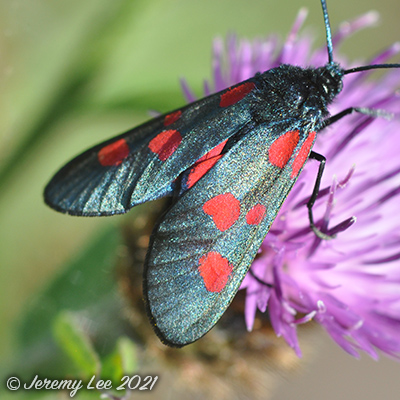
 |
|
Scientific Classifications explained » Amphibians » Ants » Aphids » Bees » Beetles » Birds » Bugs » Butterflies » Caterpillars » Damselflies » Dragonflies » Earwigs » Flies » Frog/Leafhoppers » Fungi » Galls » Grasshoppers » Harvestmen » Hoverflies » Lacewings » Ladybirds » Leaf Mines » Lichens » Mammals » Millipedes » Mosses » Moths » Sawflies » Slugs » Snails » Spiders » Trees & Shrubs » Wasps » Wild Flowers » Woodlice » Postboxes |
UK Nature > Moths > Zygaena lonicerae

Scientific Name: Zygaena lonicerae Common Name: Narrow-bordered Five-spot Burnet Zygaena lonicerae, more commonly known as the Narrow-bordered Five-spot Burnet, has a forewing of between 15 and 19 mm and is very similar to and sometimes difficult to distinguish from the Five-spot Burnet. In general, the forewing of the Narrow-bordered Five-spot Burnet is longer and more pointed, the upper angle of the hindwing is more pointed and the black border of the hindwing is narrower than those of the Five-spot Burnet. Sometimes, although infrequently, the red colour is replaced by yellow. The moth flies from early June to the end of July, during the peak flowering time for our native wildflowers which is when the supply of nectar they feed on is most plentiful. It is attracted to a range of flowers, including thistles, knapweeds, and scabious. The adults lay their eggs on various species of native wildflowers, and the larvae remain visible on the stems of the plants. They pupate in transparent cocoons, also spun and positioned on plant stems. The larval foodplants of the Narrow-bordered Five-spot Burnet Moth include Bird's-foot Trefoil, White and Red Clover, Meadow Vetchling and Sainfoin. In Britain and Ireland this moth is both common and widespread. |
|

https://www.uknature.co.uk is a website dedicated to showing the immense diversity of UK nature and wildlife. Our vast range of habitats, from lowland arable to snow covered mountains, from storm-ravaged coastlines to peaceful inland freshwater lakes and rivers, from dry, sandy heaths to deciduous and coniferous forests, all these habitats contribute to the abundance of UK nature. We have wild birds in huge numbers either residing or visiting our shores (597 recorded species as at July 2013) and we must also not forget the humble back garden with its grass lawns, flower beds filled with nectar rich flowers, shrubs and trees, all designed to attract huge numbers of insects such as bees, moths, butterflies and hoverflies; and finally the small ponds which provide safe havens for frogs, toads, newts and even slow worms and grass snakes. www.uknature.co.uk is the showcase for my personal passion, photographing uknature in all its glory. I sincerely hope you all enjoy the fruits of my labours. This site and all images contained therein is © Jeremy Lee 2004 - 2025. All Rights Reserved. Site design by Jeremy Lee. Site development & IT Support by Stuart Lee. |